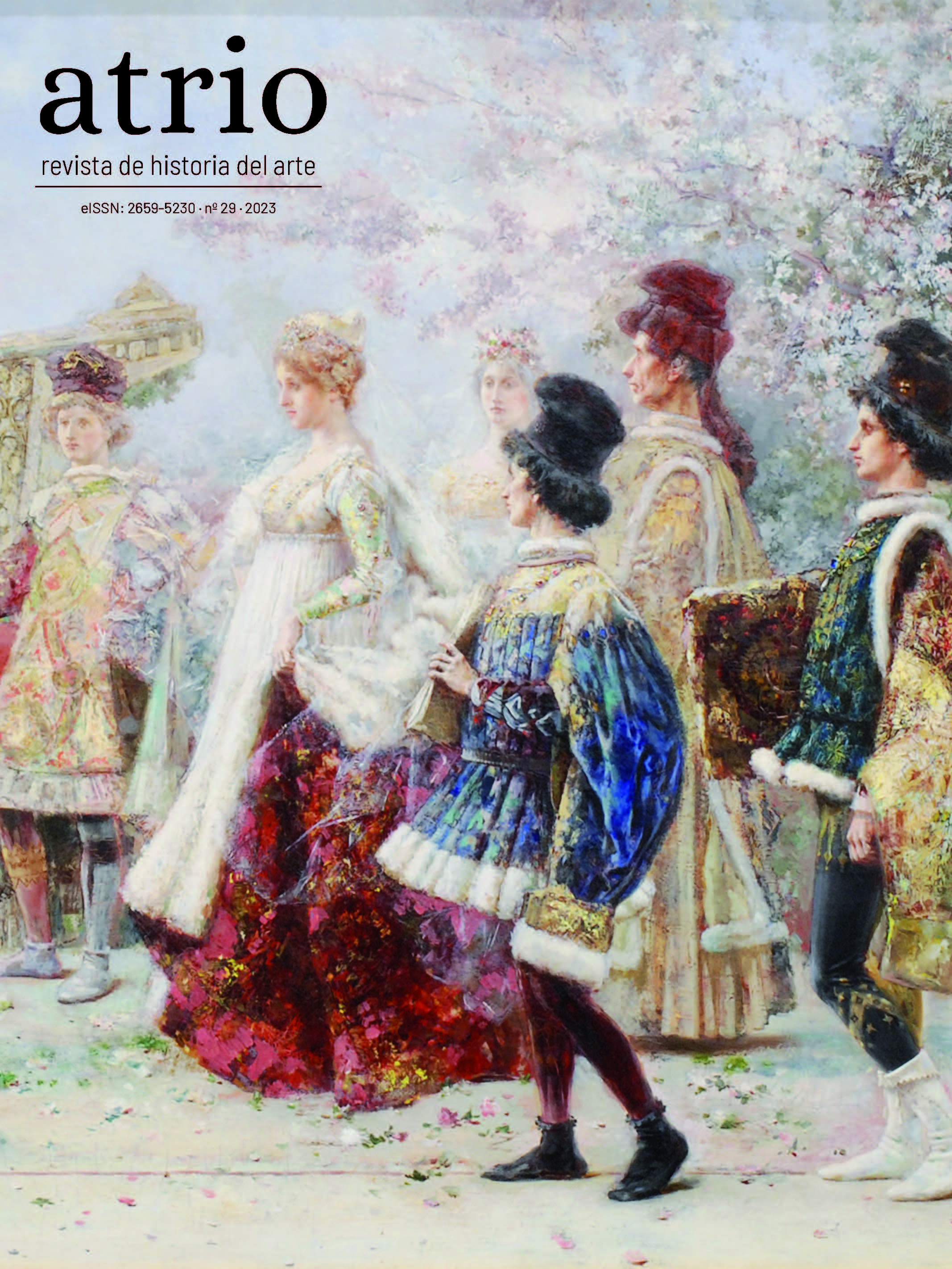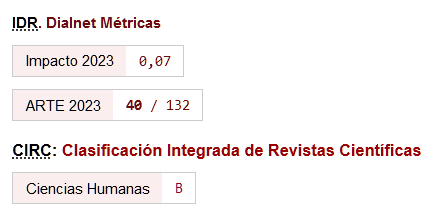The Disturbing Presence of Death. Its Representation in Uruguayan Art in Times of the Second World War.
DOI:
https://doi.org/10.46661/atrio.8130Keywords:
Uruguay, Second World War, Iconography, Death, Melancholy, PathosAbstract
The impact of the Second World War in Uruguay has traditionally been studied from its socio-economic angle, although there is still a great void regarding its impact on the cultural and artistic space. This article sets out to analyze the changes in the corpus of Uruguayan art in relation to representations of death –iconographically and expressively– since the Second World War. On the one hand, we study iconographic aspects related to the presence of death, while on the other, we suggest a series of works in which topics and atmospheres have indirect links to it. In this case, it is important the presence of melancholy by way of omnipresent form.
Downloads
References
Fuentes documentales:
Catálogo del Salón Nacional de Pintura y Escultura. Uruguay: Ministerio de Instrucción pública, 1939.
Catálogo del IV Salón Nacional de Bellas Artes. Uruguay: Ministerio de Instrucción Pública, 1940.
Catálogo del IX Salón Nacional del Dibujo y el Grabado. Uruguay: Ministerio de Instrucción Pública, 1946.
Catálogo del XII Salón Nacional del Dibujo y el Grabado. Uruguay: Ministerio de Instrucción pública, 1949.
Catálogo del XIII Salón Nacional del Dibujo y Grabado. Uruguay: Ministerio de Instrucción Pública, 1950.
Ministerio de Instrucción Pública, X Salón Nacional de Dibujo y Grabado 1947. Catálogo. Montevideo: Comisión Nacional de Bellas Artes, 1947. Publicado en conjunto con una exhibición del mismo título, organizada y presentada en el Teatro Solís de Montevideo, 1947.
Fuentes bibliográficas:
Arana, Mariano, y Lorenzo Garabelli. Arquitectura renovadora en Montevideo, 1915-1940. Montevideo: Fundación de Cultura Universitaria, 1991.
Argul, José Pedro. Las artes plásticas en Uruguay. Montevideo: Barreiro y Ramos, 1966.
Ariès, Philippe. El hombre ante la muerte. España: Taurus, 1984.
Claire, Jean. Malinconia. Madrid: La Balsa de Medusa, 1999.
Cogniat, Raymond, y Carlos Herrera Mac Lean. Exposición de Grabadores Franceses Modernos. Montevideo: Ministerio de Instrucción Pública, 1947. Publicado en conjunto con una exhibición del mismo título, organizada y presentada en Montevideo, 1947.
Ferrari, María. “Civilización.” AIAPE, no. 4 (1938): 1.
Freud, Sigmund. “Das Unheimliche.” En Obras Recopiladas, 11-29. Vol. 12. Londres: Imago, 1947.
Hermsen, Joke Johannetta Hermsen. La melancolía en tiempos de incertidumbre. Madrid: Siruela, 2019.
Hurtado, Guillermo. “Naturaleza muerta (still-life).” Dianóia, no. 64 (2020): 181-192. https://doi.org/10.22201/iifs.18704913e.2019.83.1567.
Lebeer, Louis, y Carlos Herrera Mac Lean. Grabados belgas. Montevideo: Ministerio de Instrucción Pública, 1948. Publicado en conjunto con una exhibición del mismo título, organizada y presentada en Montevideo, 1948.
Moraes Medina, Mariana. “En busca del enemigo oculto: intelectuales y revistas antinazis en el Uruguay de la Segunda Guerra Mundial.” Revista Letral, no. 24 (2020): 1-21. https://doi.org/10.30827/rl.v0i24.11690.
Orwell, George. “Los escritores y leviatán.” Estudios Públicos, no. 18 (1985): 310-315.
Peluffo Linari, Gabriel. Realismo social en el arte uruguayo. 1930-1950. Montevideo: Museo Nacional de Bellas Artes Juan M. Blanes, 1992. Publicada en conjunto con una exhibición del mismo título, organizada y presentada en el Museo Nacional de Bellas Artes Juan M. Blanes, 1992.
Peluffo Linari, Gabriel. “Liderazgo intelectual en la construcción de un espacio de interlocución social alternativo: Agrupación de Intelectuales, Artistas, Periodistas y Escritores, AIAPE (1936-1948).” Revista de la Academia Nacional de Letras, no. 15 (2019): 113-161.
Pose, Severino. “Dibujo.” AIAPE, no. 4 (1937): 8.
Pove, J. P. “El destino manifiesto.” La Pluma, no. 12 (junio de 1929): 74.
Rey Ashfield, William. “Melancolía y metafísica. Arquitectura uruguaya en tiempos de incertidumbre global.” Vitruvia, no. 6 (2020): 17-34.
Traverso, Enzo. El significado de la segunda guerra mundial. Madrid: La Oveja Roja, 2015.
Published
How to Cite
Issue
Section
License
Copyright (c) 2023 William Rey Ashfield, Daniela Kaplan Stein

This work is licensed under a Creative Commons Attribution-NonCommercial-ShareAlike 4.0 International License.
Los autores/as que publican en Atrio. Revista de historia del arte están de acuerdo con los siguientes términos:
- Los autores/as conservan los derechos de autor y garantizan a la revista el derecho de ser la primera publicación del trabajo al igual que licenciado bajo una licencia de Creative Commons Attribution-NonCommercial-ShareAlike 4.0 International License que permite a otros compartir el trabajo con un reconocimiento de la autoría de este y la publicación inicial en esta revista.
- El autor/a o cedente del material que se entrega para su publicación autoriza a la revista para que publique, sin obligación alguna (económica o de otra naturaleza), el contenido del referido manual tanto en formato papel, como en digital, así como en cualquier otro medio. Esta cesión de uso del material entregado comprende todos los derechos necesarios para la publicación del material en la revista. Quedan garantizados, simultáneamente, los derechos morales del autor
- El autor/a o cedente es plenamente consciente y está de acuerdo con que todos o cualesquiera de los contenidos proporcionados, formarán una obra cuyo uso se cede a la revista para su publicación total o parcial.
- El autor/a o cedente garantiza ser el titular de los derechos de Propiedad Intelectual sobre los contenidos proporcionados, es decir, sobre el propio texto e imágenes/fotografías/obras fotográficas que se incorporan en su artículo.
- El autor/a o cedente asegura y garantiza: (i) que todo el material enviado a la revista cumple con las disposiciones legales aplicables; (ii) que la utilización de cualquier material protegido por derechos de autor y derechos personales en la concepción del material se encuentra regularizada; (iii) que obtuvo las licencias de derechos, permisos y autorizaciones necesarias para la ejecución del material, inclusive los derechos de imagen, si fueran aplicables; y (iv) que el material no viola derechos de terceros, incluyendo, sin limitarse a estos, los derechos de autor y derechos de las personas.
- El autor/a o cedente, exime a la revista de toda y cualquier responsabilidad con relación a la violación de derechos de autor, comprometiéndose a emplear todos sus esfuerzos para auxiliar a la revista en la defensa de cualquier acusación, medidas extrajudiciales y/o judiciales. Asimismo, asume el abono a la revista de cualquier cantidad o indemnización que esta tenga que abonar a terceros por el incumplimiento de estas obligaciones, ya sea por decisión judicial, arbitral y/o administrativa.













